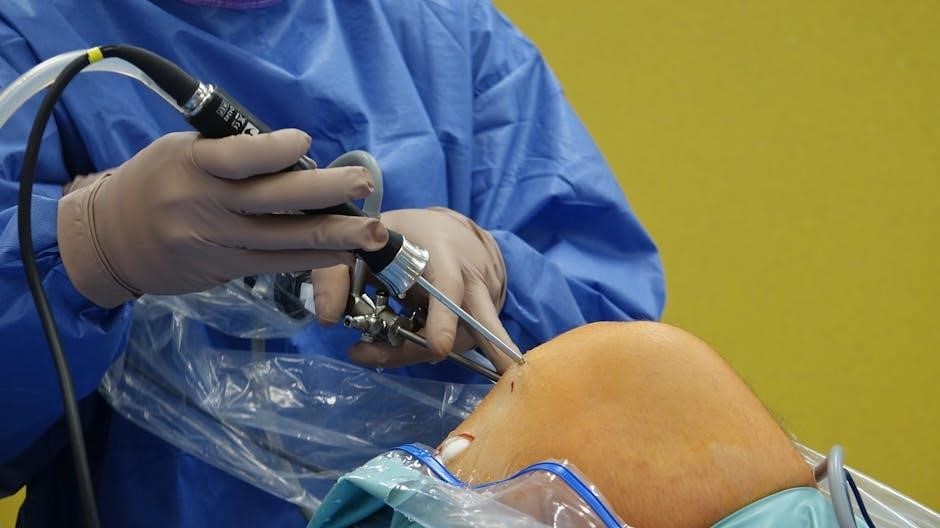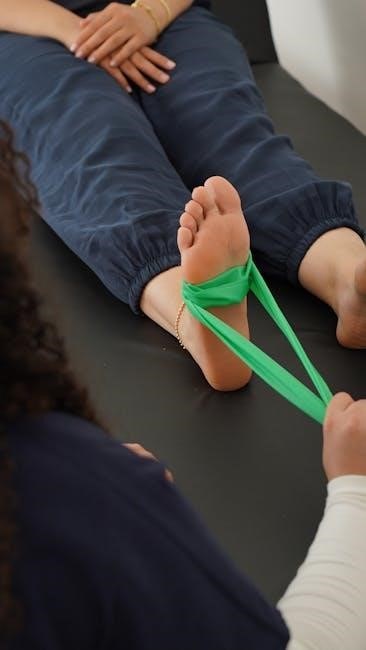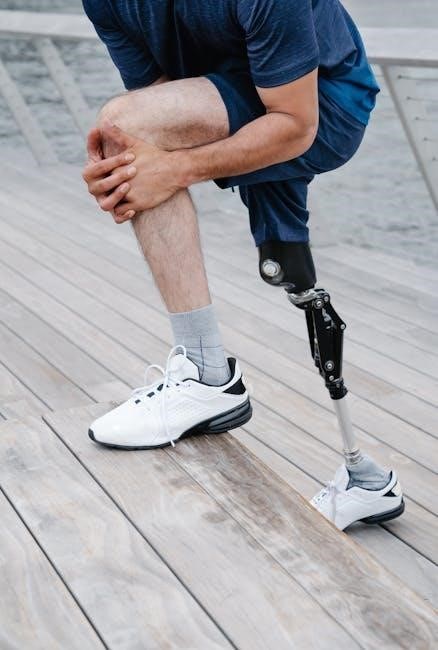Exercises Before Knee Replacement Surgery
Engaging in targeted exercises before knee replacement surgery is crucial for strengthening muscles, improving mobility, and ensuring a smoother recovery. Focus on low-impact activities like cycling and swimming to enhance joint flexibility and overall physical readiness.
Importance of Pre-Operative Exercises

Pre-operative exercises play a vital role in preparing the body for knee replacement surgery. Strengthening the muscles around the knee improves joint stability and reduces the risk of complications. Range of motion exercises enhance flexibility, making postoperative recovery smoother. Additionally, these exercises boost blood circulation, which helps prevent issues like blood clots. Patients who engage in regular prehab (preoperative rehabilitation) often experience faster recovery times and better functional outcomes. Strengthening the quadriceps, hamstrings, and calf muscles ensures better support for the new joint. Furthermore, pre-operative exercises improve mental preparation, reducing anxiety and setting realistic expectations for recovery. By following a structured exercise routine, patients can maintain independence and return to daily activities sooner. Overall, pre-operative exercises are a cornerstone of successful knee replacement surgery, laying the foundation for a more comfortable and effective recovery process.
Key Strengthening Exercises

Strengthening the muscles around the knee is essential before surgery to enhance stability and support. Quadriceps sets and hamstring curls are fundamental exercises to improve muscle tone and strength. Straight leg raises target the quadriceps without bending the knee, while seated leg extensions help build strength in the front thigh muscles. Wall slides and step-ups are effective for strengthening the quadriceps and improving balance. Strengthening the calf muscles through heel raises is also crucial for postoperative mobility. These exercises should be performed 2-3 times daily, with 10-15 repetitions per set. Using resistance bands can add intensity to the workouts. It’s important to focus on proper form to avoid injury. Strengthening the surrounding muscles ensures better joint stability and reduces the risk of complications after surgery. Regular practice of these exercises helps patients maintain independence and recover more efficiently. Consistency is key to achieving optimal results and preparing the body for the surgical procedure.

Range of Motion Exercises

Range of motion exercises are vital to maintain flexibility and mobility in the knee joint before surgery. These exercises help prevent stiffness and ensure the knee can move through its full range of motion postoperatively. Passive knee extensions and heel props are effective for improving extension, while prone hang exercises focus on gentle stretching. Sitting hamstring stretches and straight leg raises are also recommended to enhance flexibility and strength. These exercises should be performed gently to avoid discomfort or injury. Aim to practice these movements 2-3 times daily, holding each stretch for 20-30 seconds. Consistency is key to maintaining joint mobility and preparing the knee for surgery. Range of motion exercises not only improve preoperative flexibility but also lay the foundation for a smoother recovery. Regular practice helps patients regain mobility faster and reduces the risk of postoperative complications. By incorporating these exercises into your daily routine, you can ensure better knee function and overall recovery outcomes.

Low-Impact Cardiovascular Exercises
Low-impact cardiovascular exercises are essential before knee replacement surgery to improve heart health and maintain muscle strength without putting excessive strain on the knee joint. Activities like swimming, cycling, and using an elliptical machine are highly recommended as they provide a great workout while minimizing stress on the knee. Brisk walking is another effective option, as it promotes circulation and strengthens the lower limbs. These exercises help improve joint mobility, reduce stiffness, and enhance overall physical fitness, which is crucial for a smoother recovery.

It’s important to avoid high-impact activities like running or jumping, as they can exacerbate knee pain or cause further damage. Instead, focus on low-impact cardio that promotes blood flow and strengthens the muscles around the knee. Regular cardiovascular exercise also helps with weight management, which can reduce pressure on the knee joint; Always consult your healthcare provider before starting any new exercise program to ensure it’s safe and suitable for your condition. Consistency is key—aim for at least 20-30 minutes of low-impact cardio most days of the week. This will not only improve your preoperative fitness but also contribute to a faster and more successful recovery after surgery.

Proper Warm-Up and Cool-Down Routines
A proper warm-up and cool-down routine is vital to prepare the body for exercise and aid in recovery before knee replacement surgery. Start with gentle activities like leg swings, thigh marches, or heel slides to increase blood flow and flexibility. These movements help reduce stiffness and prevent muscle strain during more intense exercises.
After your workout, incorporate stretching exercises such as hamstring stretches, quadriceps stretches, and calf stretches to relax the muscles and improve joint mobility. Deep breathing exercises can also help reduce tension and promote relaxation.
Dedicate 10-15 minutes to both warm-up and cool-down routines. This ensures a safe transition into and out of physical activity, minimizing the risk of injury and enhancing the effectiveness of your workout. Consistent practice of these routines will improve circulation, reduce muscle soreness, and prepare your body for the demands of surgery and recovery.
Creating a Pre-Surgery Exercise Routine
Creating a well-structured pre-surgery exercise routine is essential to prepare your body for knee replacement surgery. Begin by consulting your healthcare provider or physical therapist to design a personalized plan tailored to your fitness level and surgical goals. Focus on a combination of strengthening, flexibility, and cardiovascular exercises to improve muscle tone, joint mobility, and overall endurance.
Aim to exercise 1-2 times daily, with each session lasting 20-30 minutes. Include activities like mini squats, straight leg raises, and seated marching to target the muscles around the knee. Gentle aerobic exercises such as swimming or cycling can also be incorporated to enhance circulation without putting excessive strain on the joint.
Track your progress and gradually increase the intensity as your strength improves. Remember to listen to your body and avoid any movements that cause pain. Consistency is key, as a well-prepared body will recover faster and adapt better to the demands of surgery.
Benefits of Prehab for Faster Recovery
Engaging in prehab, or pre-operative rehabilitation, offers numerous benefits that can significantly enhance recovery after knee replacement surgery. By strengthening the muscles around the knee and improving joint mobility, prehab helps reduce post-operative pain and stiffness. Studies show that patients who participate in prehab experience faster recovery times, achieving key milestones such as bending and straightening the knee more quickly. Additionally, prehab can improve circulation, which helps prevent complications like blood clots. Enhanced muscle strength also provides better support for the new joint, reducing the risk of future instability. Furthermore, prehab prepares patients mentally and physically, fostering a smoother transition into post-operative rehabilitation. By investing time in prehab, individuals can set themselves up for a more successful and comfortable recovery process. This proactive approach not only accelerates healing but also empowers patients to regain their independence and mobility sooner.

When to Stop or Modify Exercises
It is crucial to recognize when to stop or modify exercises before knee replacement surgery to avoid injury or exacerbating joint pain. If you experience sharp pain, swelling, or instability during or after exercise, it is a clear sign to stop and consult your healthcare provider. Additionally, high-impact activities, such as running or jumping, should be avoided to prevent further damage to the knee joint.
Modify exercises if they cause discomfort or strain. For example, replace high-impact movements with low-impact alternatives like swimming or cycling, which are gentler on the joints. Strength training should focus on controlled movements, avoiding heavy weights that may strain the knee. Always prioritize proper form and technique to minimize risk.
If you notice persistent pain or difficulty performing exercises, your surgeon or physical therapist may recommend adjusting your routine. It’s essential to balance preparation for surgery with protecting your joint health. By listening to your body and following professional guidance, you can safely optimize your pre-operative fitness.
Setting Realistic Expectations for Recovery
Setting realistic expectations for recovery after knee replacement surgery is essential for a positive and successful outcome. Patients should understand that recovery is a gradual process, with most individuals requiring several months to achieve full mobility and strength. It’s important to recognize that everyone heals at a different pace, and factors such as pre-operative fitness levels, overall health, and adherence to rehabilitation protocols can influence recovery timelines.
While some patients may return to light activities within a few weeks, full recovery often takes up to a year. It’s crucial to manage expectations and avoid comparing oneself to others. Recovery is not a linear process; some days may feel more progress-driven than others. Patients should focus on small, incremental goals, such as regaining range of motion, strengthening muscles, and improving balance.
Adequate rest, proper nutrition, and adherence to post-operative instructions are vital. Overexertion can hinder progress and increase the risk of complications. By maintaining a balanced perspective and staying committed to the rehabilitation process, patients can achieve their recovery goals and restore functionality to their knee joint. Realistic expectations help reduce frustration and promote a smoother transition back to daily activities.
